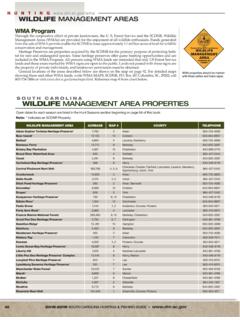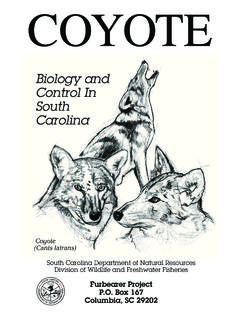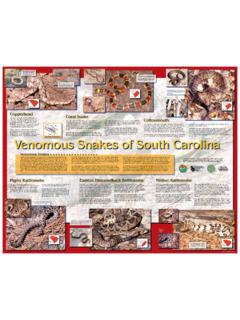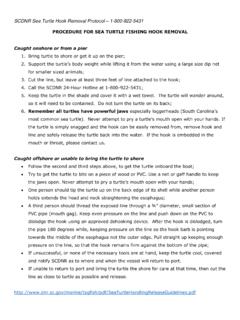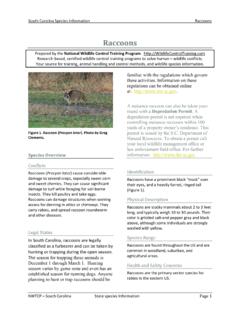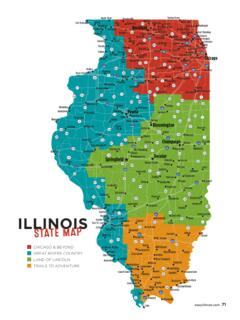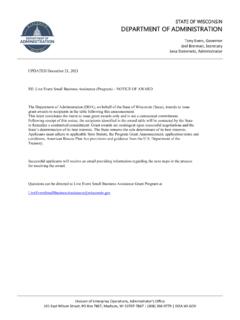Transcription of Weathering, Erosion, and Mass-Wasting Processes
1 Weathering, Erosion, and Mass-WastingProcessesDesigned to meet South Carolina Department of Education 2005 Science Academic Standards1 Table of Contents (1 of 2) Definitions: Weathering, Erosion, and Mass-Wasting (slide 4) (Standards: ; ) Types of Weathering (slide 5)(Standards: ; ) Mechanical Weathering (slide 6)(Standards: ; ) Exfoliation (slide 7)(Standards: ; ) Frost Wedging (slide 8)(Standards: ; ) Temperature Change (slide 9)(Standards: ; ) Salt Wedging (slide 10)(Standards: ; ) Abrasion (slide 11)(Standards: ; ) Chemical Weathering (slide 12)(Standards: ; ) Carbonation (slide 13)(Standards: ; ) Hydrolysis (slide 14)(Standards: ; ) Hydration (slide 15)(Standards: ; ) Oxidation (slide 16)(Standards: ; ) Solution (slide 17)(Standards: ; ) Biological Weathering (slide 18)(Standards: ; ) Lichen, Algae, and Decaying Plants (slide 19)(Standards: ; ) Plant Roots (slide 20)(Standards: ; ) Organism Activity: Burrowing, Tunneling, and Acid Secreting Organisms (slide 21) (Standards: ; ) Differential Weathering (slide 22)(Standards: ; )2 Table of Contents, cont.
2 (2 of 2) Types of Erosion (slide 23)(Standards: ; ) Fluvial (slide 24)(Standards: ; ) Aeolian (slide 25)(Standards: ; ) Ice: Glacial and Periglacial(slide 26)(Standards: ; ) Gravity (slide 27)(Standards: ; ) Types of Mass Wasting (slide 28)(Standards: ; ) Rocks Falls (slide 29)(Standards: ; ) Landslides (slide 30)(Standards: ; ) Debris and Mudflows (slide 31)(Standards: ; ) Slump (slide 32)(Standards: ; ) Creep (slide 33)(Standards: ; ) Deposition (slide 34)(Standards: ; ) Weathering, Erosion, and Mass Wasting in the Landscape (slide 35) South Carolina Science Academic Standards Grade 3 (slide 35 ; slide 36) Resources and References (slide 37)34 Definitions Weathering, erosion, Mass-Wasting , and depositional Processes occur at or near the Earth s surface and produce changes to the landscape that influence surface and subsurface topography and landform development.
3 Weatheringis the physical disintegration or chemical alteration of rocks at or near the Earth s surface. Erosionis the physical removal and transportation of weathered material by water, wind, ice, or gravity. Mass wasting is the transfer or movement of rock or soil down slope primarily by gravity. Depositionis the process by which weathered and eroded materials are laid down or placed in a location that is different from their source. These Processes are all very important to the rock cycle because over geologic time weathering, erosion, and mass wasting transform solid rock into sediments and soil that result in the redepositionof material forming new sedimentary rocks. Table of ContentsStandard: : of WeatheringI. Mechanical (physical) weatheringis the physical disintegration and reduction in the size of the rocks without changing their chemical composition.
4 Examples: exfoliation, frost wedging, salt wedging, temperature changes, and abrasionII. Chemical weatheringdecomposes, dissolves, alters, or weakens the rock through chemical Processes to form residual materials. Examples: carbonation, hydration, hydrolosis, oxidation, and solutionIII. Biological weatheringis the disintegration or decay of rocks and minerals caused by chemical or physical agents of organisms. Examples: organic activity from lichen and algae, rock disintegration by plant or root growth, burrowing and tunneling organisms, and acid secretion5 Table of ContentsStandard: : Mechanical WeatheringMechanical weatheringis the physical disintegration and reduction in the size of the rocks without changing their chemical composition. Exfoliation Frost Wedging Salt Wedging Temperature Changes AbrasionPhoto courtesy of SCGSM echanical weathering Processes disintegratemetamorphic rocks in South Carolina s Piedmont Region.
5 6 Table of ContentsStandard: : Weathering: Exfoliation Exfoliation is a mechanical weathering process whereby pressure in a rock is released along parallel alignments near the surface of the bedrock and layers or slabs of the rock along these alignments break off from the bedrock and move downhill by gravity. Exfoliation primarily occurs on intrusive igneous or metamorphosed rocks that are exposed at the Earth s surface. Exfoliation can occur both very slowly or very rapidly as a form of mass wasting. Large rocks characterized by exfoliation are commonly referred to as exfoliation domes. Table Rock mountain in South Carolina, and Enchanted Rock in Texas are both examples of exfoliation domes with large slabs of rock exfoliating from the Rock in the Texas hill country is an example of an exfoliation dome.
6 As pressure is released from the surface layer, slabs of rock exfoliate from the dome and move down slope. As they are transported down slope, weathering and erosion Processes break the rocks into progressively smaller fragments. Overtime, each new layer that is exposed will eventually exfoliate, from the of ContentsPhoto: SCGSS tandard: : Weathering: Frost Wedging Frost wedging is a mechanical weathering process caused by the freeze-thaw action of water that is trapped between cracks in the rock. When water freezes, it expands and applies pressure to the surrounding rock forcing the rock to accommodate the expansion of the ice. This process gradually weakens, cracks, and breaks the rock through repetitive freeze-thaw weathering cycles. Frost wedging generally produces angular blocks and talus material.
7 Talus is a term used to describe weathered rock fragments deposited at the base of a hill slope or mountain. Copyright Bruce Molnia, USGSThis example of frost wedging is from Pikes Peak in Colorado. The weathered fragments of rock break apart from the exposed rock from freeze-thaw action and collect as angular blocks of talus material. 8 Table of ContentsStandard: : Changes Daily (diurnal) and seasonal temperature changes affect certain minerals and facilitates the mechanical weathering of bedrock. Warmer temperatures may cause some minerals to expand, and cooler temperatures cause them to contract. This gradual expansion and contraction of mineral grains weakens the rock causing it to break apart into smaller fragments or to fracture. This process is more common in desert climates because they experience extreme fluctuations in daily temperature changes.
8 Temperature changes are often not the dominant form of weathering, but instead temperature changes tend to accelerate other forms of weathering already occurring. Copyright 2008 Imperial College LondonThe rock fragments in the lower right side of this image have weathered as a result of extreme fluctuations in day and night temperature changes. 9 Table of ContentsStandard: : Weathering: Salt Wedging Salt wedging occurs when salts crystallize out of solution as water evaporates. As the salt crystals grow, they apply pressure to the surrounding rock weakening it, until it eventually cracks and breaks down, enabling the salt crystal to continue growing. Salt wedging is most common in drier climates, such as deserts. Copyright Michael CollierThese salt crystals were foundgrowing between rock fractures in California s Death Valley.
9 10 Table of ContentsStandard: : Weathering: Abrasion Abrasion occurs when rocks collide against each other while they are transported by water, glacial ice, wind, or gravitational force. The constant collision or gravitational falling of the rocks causes them to slowly break apart into progressively smaller particles. Flowing water is the primary medium of abrasion and it produces the rounded shape of fluvial sediments. During abrasion, rocks may also weather the bedrock surface they are coming into contact with as well as breaking into smaller particles and eventually individual grains. In addition to the transported rocks being weathered by abrasion, the bedrock surface is also experiencing the effects of collision and mechanical weathering. This smoothes the surface of the bedrock and can also cause it to break Source: SCGSA brasion Processes in creek bedsproduce rounded boulders and time, abrasion Processes will eventually break these rocks into progressively smaller particle sizes, such as gravel, sand, silt, and of ContentsStandard: : of Chemical WeatheringChemical weatheringdecomposes, dissolves, alters, or weakens the rock through chemical Processes to form residual materials.
10 Carbonation Hydrolysis Hydration Oxidation SolutionCopyright Oklahoma UniversityStalactite and stalagmite joining together in Onondaga cave State park , Missouri. 12 Table of ContentsStandard: : Weathering: Carbonation Carbonation is a process by which carbon dioxide and rainwater or moisture in the surrounding environment chemically react to produce carbonic acid, a weak acid, that reacts with carbonate minerals in the rock. This process simultaneously weakens the rock and removes the chemically weathered materials. Carbonation primarily occurs in wet, moist climates and effects rocks both on and beneath the surface. Carbonation occurs with limestone or dolomite rocks and usually produces very fine, clayey weathered by carbonation Processes Photo source: Wikipedia GNU Free Documentation License13 Table of ContentsStandard: : Weathering: Hydrolysis Hydrolysis is a chemical reaction between H+and OH-ions in water and the minerals in the rock.

